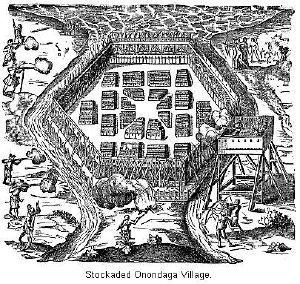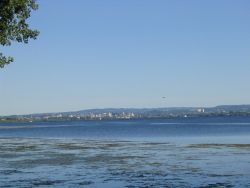Onondaga (tribe)
| Onondaga | ||||||
|---|---|---|---|---|---|---|
| Total population | ||||||
| 80,000+ | ||||||
| Regions with significant populations | ||||||
|
| ||||||
| Languages | ||||||
| English, Onöñda'gega', Other Iroquoian Dialects | ||||||
| Religions | ||||||
| Longhouse, Handsome Lake, Gai'hwi:io, Kanoh'hon'io, Kahni'kwi'io, Other Indigenous Religion | ||||||
| Related ethnic groups | ||||||
| Seneca Nation, Oneida Nation, Tuscarora Nation, Mohawk Nation, Cayuga Nation, other Iroquoian peoples |
The Onondaga (Onöñda'gega' or the People of the Hills) are one of the original five constituent nations of the Iroquois (Haudenosaunee) Confederacy. Their traditional homeland is in and around Onondaga County, New York. Being centrally located, they were the Keepers of the Fire (Kayečisnakweˀnì•yuˀ[1] in Tuscarora) in the figurative longhouse, with the Cayuga and Seneca to their west and the Oneida and Mohawk to their east. For this reason, the League of the Iroquois historically met at the Iroquois government's capital at Onondaga, as indeed the traditional chiefs do today.
History
In the American Revolutionary War, the Onondaga were at first officially neutral, although individual Onondaga warriors were involved in at least one raid on American settlements. After an American attack on their main village on April 20, 1779, the Onondaga later sided with the majority of the League and fought against the United States in alliance with the British. Thereafter, many Onondaga followed Joseph Brant to Six Nations, Ontario, after the United States was accorded independence.
On November 11, 1794, the Onondaga Nation, along with the other Haudenosaunee nations, signed the Treaty of Canandaigua with the United States, in which their right to their homeland was acknowledged by the United States in article II of the treaty.[2]
Culture
Other spellings of their name include:
- Onöñda'gega' Onondaga Language
- Onontakeka Oneida Language
- Onondagaono Seneca Language
Language
Onondaga Nation Language (Onöñda’gega’ (IPA /onũtaʔkekaʔ/), "People of the Hills") is the language of the Onondaga First Nation, one of the original five constituent tribes of the League of the Iroquois (Hodenosaunee).
This language is spoken in the United States and Canada, primarily on the reservation in central New York state, and near Brantford, Ontario.
Like all Iroquoian languages, Onondaga is a polysynthetic language, meaning that many grammatical and lexical concepts are expressed as morphemes (that is a affixes of one complex word) rather than separate words. This means that many concepts which could take many words to express in English can be express in a single word in Onondaga.
Contemporary Onondaga
Those Onondaga remaining in New York are under the government of traditional chiefs nominated by clan mothers, rather than elected. On March 11, 2005, the Onondaga Nation of Nedrow, New York, filed a land rights action in federal court, seeking acknowledgment of title to over 3,000 square miles (7,800 km²) of ancestral lands centering in Syracuse, New York. In doing so they hope to obtain increased influence over environmental restoration efforts at Onondaga Lake and other EPA Superfund sites in the claimed area. This lawsuit is facing a motion to dismiss based on the precedent established in the Cayuga nation's land claim[1] and other defenses.
- Onondaga Nation in Nedrow, New York outside Syracuse
- Onondaga of Ohswegen and Bearfoot Onondaga, both at Six Nations of the Grand River, Ontario, Canada
Notable Onondaga people
- Oren Lyons [Lives at Onondaga and holds a Faithkeeper title, but is Seneca]
- Sid Hill [Tadodaho]
- Tom Longboat [Six Nations]
Onondaga Lake
Onondaga Lake is northwest of the city of Syracuse, New York and south of Lake Ontario. Water outflows from the lake to Lake Ontario through the Oswego River. Around 1450 or possibly earlier, Onondaga Lake was the site of the founding of the Haudenosaunee (Iroquois) Confederacy. According to legend, at this spot the warlike Onondaga chief Tadodaho was persuaded by Hiawatha and Deganawidah (the Peacemaker) to accept the Great Law of Peace. Historically, the lake and the surrounding area was a site of salt springs and later salt mining.
Notes
- ↑ Rudes, B. Tuscarora English Dictionary Toronto: University of Toronto Press, 1999
- ↑ 1794 Canandaigua Treaty Commemoration Committee, Inc.
ReferencesISBN links support NWE through referral fees
- Calloway, Colin G. 2004. First Peoples. Boston, MA: Bedford/St. Martin's. ISBN 0-312-39889-1.
- Onondaga Reservation, New York United States Census Bureau. Retrieved November 11, 2007.
Woodbury, Hanni. 2002. Onondaga-English/English-Onondaga Dictionary. Toronto: University of Toronto Press.
External links
| Iroquois Confederacy | |
|---|---|
| Nations | Cayuga · Mohawk · Oneida · Onondaga · Seneca · Tuscarora |
| Topics | Economy · Languages · Mythology · Great Law of Peace · The Great Peacemaker |
Credits
New World Encyclopedia writers and editors rewrote and completed the Wikipedia article in accordance with New World Encyclopedia standards. This article abides by terms of the Creative Commons CC-by-sa 3.0 License (CC-by-sa), which may be used and disseminated with proper attribution. Credit is due under the terms of this license that can reference both the New World Encyclopedia contributors and the selfless volunteer contributors of the Wikimedia Foundation. To cite this article click here for a list of acceptable citing formats.The history of earlier contributions by wikipedians is accessible to researchers here:
The history of this article since it was imported to New World Encyclopedia:
Note: Some restrictions may apply to use of individual images which are separately licensed.



